Intel Xeon E Six-Core Review: E-2186G, E-2176G, E-2146G, and E-2136 Tested
by Ian Cutress on November 5, 2018 12:00 PM EST- Posted in
- CPUs
- Intel
- Xeon
- Enterprise CPUs
- Xeon E
Gaming: Grand Theft Auto V
The highly anticipated iteration of the Grand Theft Auto franchise hit the shelves on April 14th 2015, with both AMD and NVIDIA in tow to help optimize the title. GTA doesn’t provide graphical presets, but opens up the options to users and extends the boundaries by pushing even the hardest systems to the limit using Rockstar’s Advanced Game Engine under DirectX 11. Whether the user is flying high in the mountains with long draw distances or dealing with assorted trash in the city, when cranked up to maximum it creates stunning visuals but hard work for both the CPU and the GPU.
For our test we have scripted a version of the in-game benchmark. The in-game benchmark consists of five scenarios: four short panning shots with varying lighting and weather effects, and a fifth action sequence that lasts around 90 seconds. We use only the final part of the benchmark, which combines a flight scene in a jet followed by an inner city drive-by through several intersections followed by ramming a tanker that explodes, causing other cars to explode as well. This is a mix of distance rendering followed by a detailed near-rendering action sequence, and the title thankfully spits out frame time data.
| AnandTech CPU Gaming 2019 Game List | ||||||||
| Game | Genre | Release Date | API | IGP | Low | Med | High | |
| Grand Theft Auto V | Open World | Apr 2015 |
DX11 | 720p Low |
1080p High |
1440p Very High |
4K Ultra |
|
There are no presets for the graphics options on GTA, allowing the user to adjust options such as population density and distance scaling on sliders, but others such as texture/shadow/shader/water quality from Low to Very High. Other options include MSAA, soft shadows, post effects, shadow resolution and extended draw distance options. There is a handy option at the top which shows how much video memory the options are expected to consume, with obvious repercussions if a user requests more video memory than is present on the card (although there’s no obvious indication if you have a low end GPU with lots of GPU memory, like an R7 240 4GB).
All of our benchmark results can also be found in our benchmark engine, Bench.
| Game | IGP | Low | Medium | High |
| Average FPS | 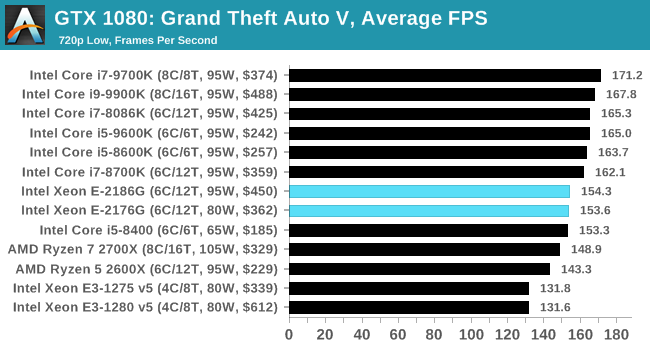 |
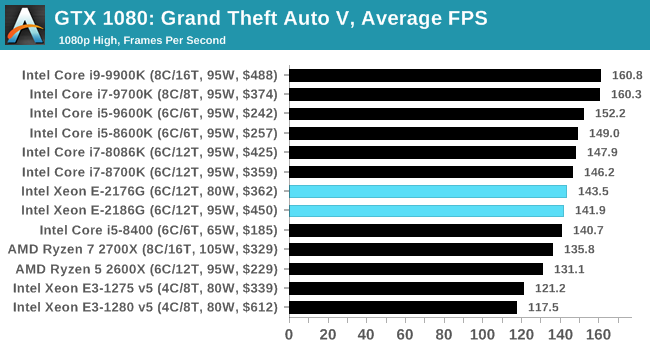 |
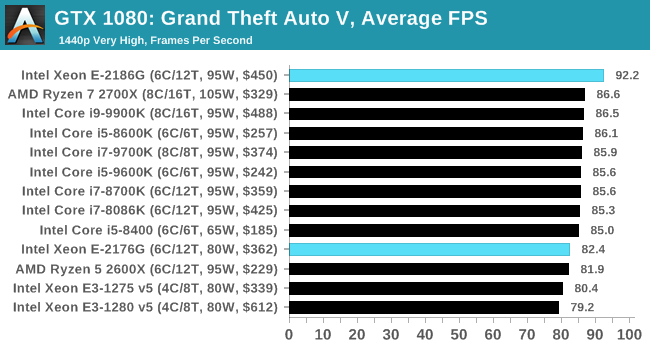 |
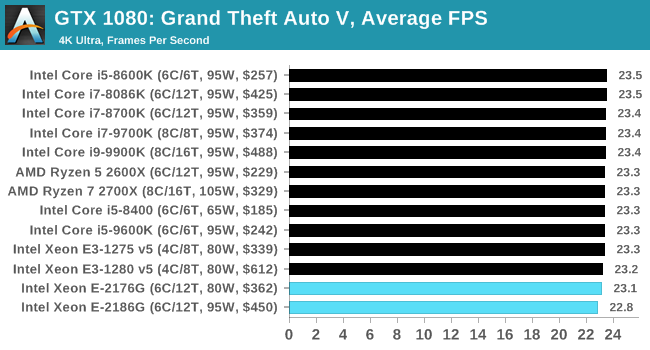 |
| 95th Percentile | 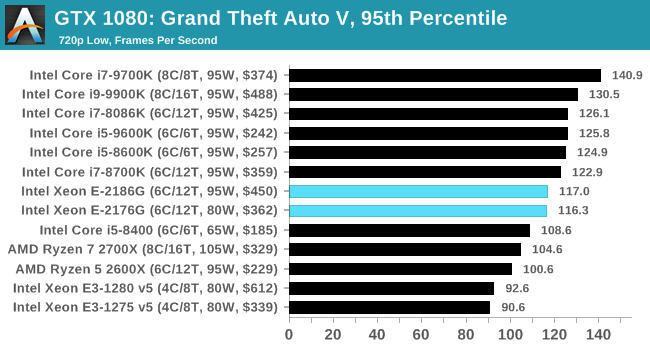 |
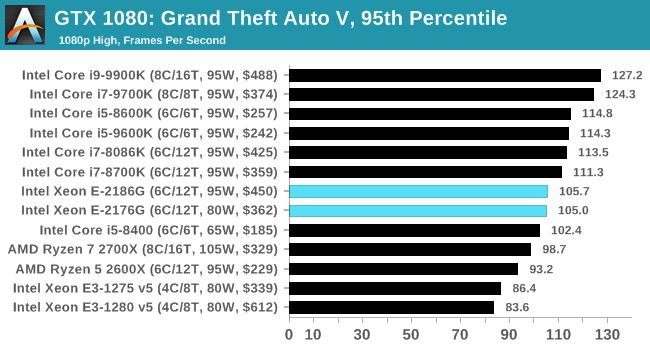 |
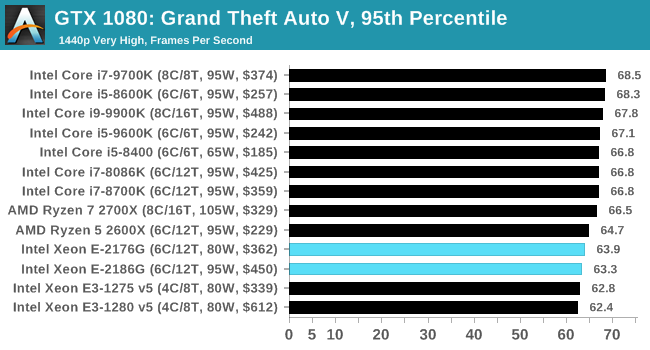 |
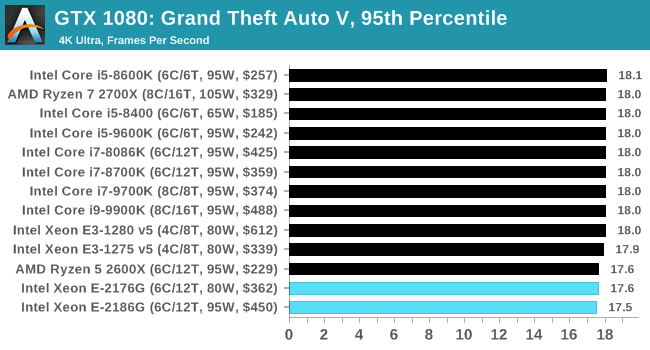 |












48 Comments
View All Comments
A5 - Monday, November 5, 2018 - link
Smaller/cheaper systems for places that still self-host? Not everyone needs (or has the budget for) a 28-core monster box.I have to admit I'm not sure why it gets a 21-page AT writeup, but I think their low-end enterprise tests do decent traffic.
jtd871 - Monday, November 5, 2018 - link
Ya, and there are still a truly dizzying array of SKUs on display here when only maybe 4 might be justifiable for a 6-core workstation CPU market. Gotta love product segmentation.speculatrix - Tuesday, November 6, 2018 - link
I agree, small businesses (like me) want a small dev server to run VMs, and an eight core (no HT) single socket box could be reasonably cost effective. There's a big jump in pricing to dual socket high core counts.notb - Wednesday, November 7, 2018 - link
These CPUs are primarily designed for workstations and purpose built servers. There is quite a huge market between home PCs and AWS datacenters. :-PThere are multiple scenarios for which these Xeons will be the most cost-effective or even the fastest ECC-enabled CPUs available. Intel can provide a perfect CPU for a particular use case, so they do. :-)
twtech - Sunday, November 18, 2018 - link
Workstation reliability. Consumer class systems are pretty reliable, but Xeons with ECC even more so.Azurael - Monday, November 5, 2018 - link
So am I reading this correctly: Intel expects people to pay extra for old Coffee Lake chips and buy a more expensive, niche motherboard just to get ECC support when every single AMD Ryzen CPU supports ECC?That would be laughable if the 'free' market actually worked, but given the fact that Intel commands such control over the system integrators and the PC industry as a whole, SIs aren't even marketing AMD hardware to their business customers (or home users for the most part, for that matter...)
kpb321 - Monday, November 5, 2018 - link
Intel has always loved to charge extra where ever they can. ECC, Virtualization and any number of other things over the years so that really isn't a surprise. On the Ryzen side my understanding is that while AMD doesn't disable it in the CPUs most consumer motherboards don't support ECC as it requires some extra memory traces. So while the AMD situation is better you can't just use ECC in any random Ryzen system.Azurael - Monday, November 5, 2018 - link
AFAIK you are correct in that actual VIOS-side support is hit and miss and rrequires motherboard manufacturers to actually implement the watchdog calls to halt the system on a double fault (although ECC does correct single bit faults without any intervention so long as it's working.) but it requires no extra hardware and would be easily implemented by an SI trying to sell a complete Ryzen system to a customer, so that's really no excuse.Azurael - Monday, November 5, 2018 - link
*BIOS-side, obviously (technically wrong anyway but I guess we can consider EFI a type of BIOS if we aren't going by strict definitions.) Stupid on-screen keyboard.kpb321 - Monday, November 5, 2018 - link
Doesn't it also require additional traces on the MB to transmit the ECC info as the memory controller is doing the ECC calculation and checking not the memory module itself?